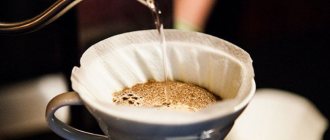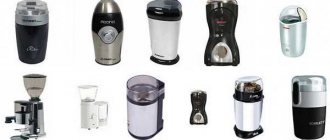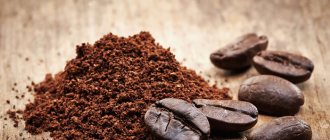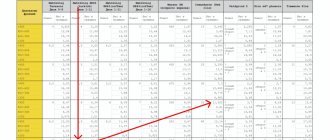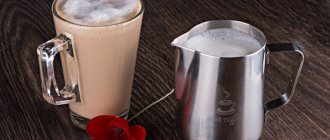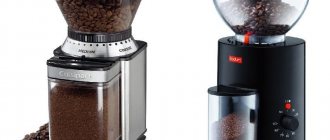What is a coffee tamper and why is it needed?
Every professional barista or true fan of quality espresso in their home kitchen has a tamper. This is not a whim or a tribute to fashion. Temper has important functional significance.
The name of the accessory comes from the English term “tamping”, translated as “tamping”.
The tamper presses the coffee in the portafilter, compacting the coffee powder into a coffee tablet. Tamping is needed to slow down the rate of water flow through it, as well as to increase the uniformity of wetting of the coffee. An even flow of water through the entire coffee mass ensures optimal extraction, and, consequently, high quality of the finished drink. If the water flows too quickly or unevenly, the coffee will be weak, watery, and overly sour.
The professionalism of a barista means the consistent taste of every cup of espresso brewed. Good temping compacts each coffee tablet, allowing water to flow evenly at a low speed.
Tempering is so important to a barista that there are special workshops and classes that focus only on tamping techniques. There are also special educational materials: books, lectures, and video courses. And they all directly point out: the quality of the tamper determines the temperament. That is why this small accessory is a must-have tool for a good barista or a fan of real espresso.
What types of tempera are there?
Temperas come in different shapes and materials from which they are made.
Flat or oval base
Temperas are produced with a flat surface and with a rounded one. There are many opinions about which form of tempera base is best. It is believed that Americans are inclined towards oval, Europeans - towards flatter. In practice, it has been proven that an oval base is better suited to a single portafilter, and a flat base is better suited to a double one. Professionals, as a rule, use distempers with an oval base. The main task of the barista when pressing is to achieve uniform pressure over the entire plane of the coffee in the portafilter, and the tamper with which base to use for this is a matter of taste and convenience.
Flat tampers tamp the coffee (along the edges and in the middle) absolutely evenly, while conical tampers press a little harder and press the coffee along the walls of the holder. It cannot be said that some of them are better and others are worse - each type of tempera has its own “admirers” and “detractors”. The main thing you should pay attention to: the tamping part of the tamper must be free of dents, scratches, chips, stampings, it must be absolutely even and smooth, otherwise the coffee will be compacted into the holder unevenly, which will spoil the taste of the drink.
Coffee tampers: shape, type, material of manufacture
For a long time, temperas were made from simple and cheap plastic, until the American Rage Barber, dissatisfied with the inconvenience of working with plastic models and the quality of the tamper, decided to take matters into his own hands. He began to produce heavy temperas with comfortable, ergonomic handles. Now his company is an industry leader, and branded tampers from Barber often become prizes at professional competitions.
The niche was quickly mastered by other manufacturers of coffee accessories, continuing and developing the idea of a convenient and weighty tamper. Today they are produced from different materials, with platforms of various sizes and shapes.
Tempera platform shape
It can be flat or convex, round. Baristas and experts still can't agree on which form is best.
- The flat platform allows you to create a uniform coffee tablet.
- Convex tampers compact the middle of the coffee, leaving the sides of the tablet slightly higher.
Each option has its fans. Entire monographs have been written about the advantages of one form or another of the platform. Setting aside the emotions surrounding this topic, flat platforms are suitable for double portafilters, while convex tampers give good results for single portafilters.
Flat tampers can have a smooth platform or a convex pattern in the form of concentric circles that leave marks on the ground coffee. Experts agree that there is no functional difference between a smooth or patterned platform; this does not affect the quality of temping.
Material of manufacture
- Plastic is the cheapest material; low-quality temperas are made from it.
- Aluminum is better than plastic, but is susceptible to corrosion in wet environments and is too light for a good seal.
- Steel is the best material for distemper soles, as it is heavy, durable, durable, and does not oxidize or rust.
- Wood - not platforms are made from it, but handles for the best dispensers.
Dimensions
There are two important dimensional parameters - the diameter and height of the distemper platform. For branded models of industrial production, the platform diameter is usually standard: 53, 57 or 58 mm, height – 7-10 mm. For hand-made tampers, these parameters are calculated during manufacture and depend on the size of the portafilter. The ideal diameter of the tamper should be 0.5-1 mm smaller than the diameter of the filter. If the holder is cone-shaped, then the diameter of the platform is calculated for the narrowest part.
Manufacturers and prices
Accessories are produced by many manufacturers of coffee equipment for baristas: Motta, Tiamo, Brewista. The cost of steel tampers with wooden handles ranges from 2100-2200 rubles. All-steel cast temperas are cheaper - from 1,500 rubles.
Unbranded accessories will cost from 1,100 rubles.
Branded temperas from Reg Barbera cost from 4.5-5 thousand rubles. But it is possible to assemble an accessory to order, choosing separately the handle and platform according to your taste and size.
Criteria for choosing coffee tampers
Barista preferences are individual; everyone has their own criteria by which models are compared. However, to make a successful purchase, you need to understand what to pay attention to first. Without knowing these things, buyers make mistakes when choosing a device.
- Base shape. There are flat and oval models.
- Material. It was mentioned that plastic, aluminum, stainless steel and wood are used. Models made from good materials are more expensive.
- Color. The manufacturer can create a model range in several colors.
- Design. Four basic construction types were previously listed: double-sided, stamped, gauged, and
- Dimensions. The width, length and height of the device must correspond to the dimensions of the coffee machine basket. Basically, the diameter of the tempera fits into the range of 51-59 mm.
- Brand. Brand names tend to be of higher quality.
- Functionality of a coffee machine or coffee maker. Despite the importance of choosing the right tamper, you should also consider the technical capabilities of the coffee machine. A device with the function of preparing different types of coffee must meet the needs of the buyer.
How to choose a tamper?
Models with a steel platform and a wooden handle are considered comfortable and functional. They are reliable and last a long time. You can buy a ready-made accessory or make it to order according to drawings.
In order to choose a good tamper, you need to know some of the features of the coffee maker you will be working with.
- Portafilter diameter. The tamper you purchase should be only slightly smaller in diameter than the narrowest part of the filter. If the tamper is too small, it will be difficult to tamp the coffee.
- Double or single filter in a coffee maker. For a double holder, experts advise buying a flat tamper; for a single holder, you can choose the shape of the platform to your liking. If you are just starting to work with coffee, it is better to take a flat tamper; it will allow you to quickly achieve uniform tamping. However, only the barista himself can give a definite answer on the preferred form of the tamper while working.
How to use a coffee tamper
Learning to use the unit effectively is not so easy. Professional baristas learn this skill in special courses. Recommendations for temping contain one main rule: the dimensions of the instrument must ideally match the dimensions of the holder.
Making delicious coffee is a labor-intensive process. First you need to determine the correct amount of grinding. For this, beginners use electronic scales. Coffee is poured into a holder on the mat to prevent slipping. After this, you need to gently tap on the sides so that the substance is distributed in the filter.
At the end, the distemper is pressed tightly to the surface to form an even and smooth “tablet”.
Coffee tamper: our conclusion
- Needed for uniform compaction of dry coffee in a holder (portafilter).
- It can have a flat or convex platform; which is better is up to the barista to decide.
- The best tampers have a stainless steel platform and a wooden handle.
- The diameter of the tempera platform should be 0.5-1 mm smaller than the diameter of the coffee machine filter.
- They are produced by different manufacturers, but products from Reg Barbera are considered luxury.
- Cost – from 2000 rubles.
- Can be made to order.
Barista equipment - what and why
The holder (horn, portafilter) is considered part of the coffee maker. Ground coffee is poured into it and tempered (pressed) with a special tool - a tempera before preparation.
Holders are different. One/two sometimes even three servings. They differ in the size of the basket (7-8g, 14-16g, 18-21g) and the number of spouts from which coffee is poured. Depending on the number of spouts and the size of the basket in the portafilter itself, you can prepare several servings at once (7-8 grams - a bookmark for 1 serving of espresso).
They differ in shape, diameter and material of manufacture. Holders also differ in the presence or absence of a bottom.
A tamper is a device used for pressing ground coffee in a holder.
Temperas come in different diameters (depending on the diameter of the holder), as well as different shapes and handle lengths. Each barista selects a holder specifically for himself, focusing on how anatomically it fits his hand. Temperas come with a flat base and a convex one. For a two-portion holder, either a tamper with a convex base or a flat one can be used, but for a single-portion holder, a tamper with a convex base is more suitable. This is due to the fact that the basket of a single-serve holder has a slightly different shape and a tamper with a flat base will not fit well enough during tempering.
Single-serve holder basket
Double portion holder basket
Pitcher (milk jug) is a special jug for frothing milk, made primarily of stainless steel.
Used to froth milk to prepare milk-based coffee drinks. Pitchers come in different volumes: 150ml, 350ml, 600ml, 1l and others. Typically, several different milk jugs are used at once during the work process.
Jigger is a stainless steel measuring cup. Designed for preparing and measuring the “blank” of espresso. Mainly used in making lattes and other dairy drinks.
Knock box - a box, box or large jug with a rubberized or wooden crossbar, designed to knock out pressed and spent coffee tablets from the portafilter.
Demitas is a cup (usually white) with a volume of about 80 ml, used for making espresso. For cappuccino there are demitas of increased volume 150-220 ml.
Thermometer - Used to check the temperature of frothed milk and brewed espresso. The temperature of the milk foam should be 60-65 °C, the temperature of the espresso in the cup immediately after extraction is about 80 °C.
Towels and rags. Any barista’s “arsenal” must always include towels and rags in order to wipe and keep groups, steamers (with the help of which milk is frothed), holders clean and to maintain general cleanliness in the work area.
A shaker is a special metal closed vessel used for preparing drinks and cocktails by shaking.
Scale – Used to measure the weight of a shot of espresso or check the doser of a coffee grinder. One serving of ground coffee is 7-9g.
Timer – used to measure extraction time (time of interaction of coffee with water). Espresso extraction time 25 ± 3 sec.
A blind holder is a portafilter (basket) without holes for water to exit the group. Designed for cleaning groups of coffee oils at the end of a shift.
Instead of a blind holder, a universal plug is often used, which performs the same function.
You can buy all the necessary equipment for barista work here: barista equipment
. Enjoy your coffee!
13.10.2017

